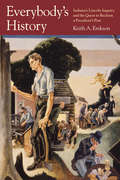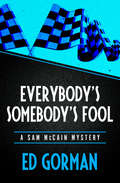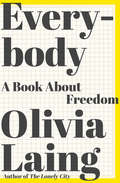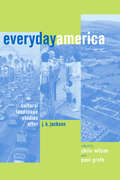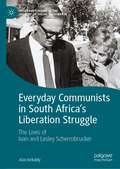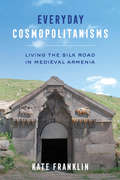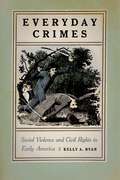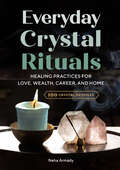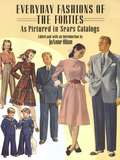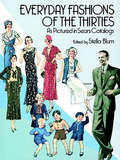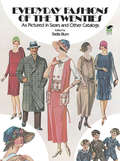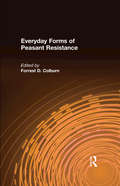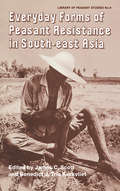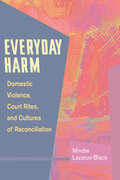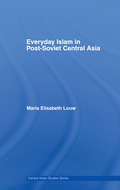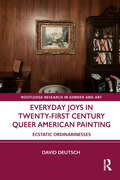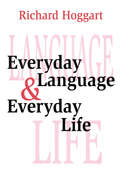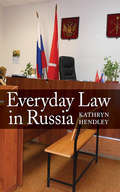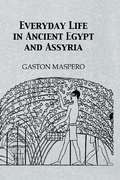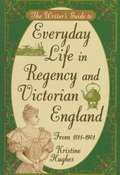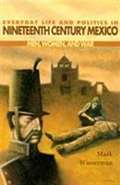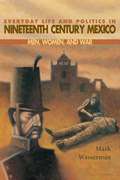- Table View
- List View
Everybody's Heard about the Bird: The True Story of 1960s Rock 'n' Roll in Minnesota
by Rick ShefchikIf you didn&’t experience rock and roll in Minnesota in the 1960s, this book will make you wish you had. This behind-the-scenes, up-close-and-personal account relates how a handful of Minnesota rock bands erupted out of a small Midwest market and made it big. It was a brief, heady moment for the musicians who found themselves on a national stage, enjoying a level of success most bands only dream of.In Everybody&’s Heard about the Bird, Rick Shefchik writes of that time in vivid detail. Interviews with many of the key musicians, combined with extensive research and a phenomenal cache of rare photographs, reveal how this monumental era of Minnesota rock music evolved. The chronicle begins with musicians from the 1950s and early 1960s, including Augie Garcia, Bobby Vee, the Fendermen, and Mike Waggoner and the Bops. Shefchik looks at how a local recording studio and record label, along with Minnesota radio stations, helped make their achievements possible and prepared the way for later bands to break out nationally. Shefchik delves deeply into the Trashmen&’s emblematic rise to fame. A Minneapolis band that recorded a fluke novelty hit called &“Surfin&’ Bird&” at Kay Bank Studios, the Trashmen signed with Soma Records, topped the local charts in late 1963, and were poised to top the national charts in early 1964. Hundreds of Minnesota bands took inspiration from the Trashmen&’s success, as teen dances with live bands flourished in clubs, ballrooms, gyms, and halls across the Upper Midwest. Here are the stories of bands like the Gestures, the Castaways, and the Underbeats, and the triumphs—and tragedies—of the most prominent Minnesota-spawned bands of the late 1960s, including Gypsy, Crow, and the Litter.For the baby boomers who remember it and everyone else who has felt its influence, the 1960s rock-and-roll scene in Minnesota was an extraordinary period both in musical history and popular culture, and now it&’s captured fully in print for the first time. Everybody&’s Heard about the Bird celebrates how these bands found their singular sound and played for their elated audiences from the golden era to today.
Everybody's History: Indiana's Lincoln Inquiry and the Quest to Reclaim a President's Past
by Keith A. EreksonRevered by the public, respected by scholars, and imitated by politicians, Abraham Lincoln remains influential more than two hundred years after his birth. His memory has inspired books, monuments, and museums and also sparked controversies, rivalries, and forgeries. That so many people have been interested in Lincoln for so long makes him an ideal subject for exploring why history matters to ordinary Americans as well as to academic specialists. In Everybody's History, Keith A. Erekson focuses on the Southwestern Indiana Historical Society--an organization composed of lawyers, historians, collectors, genealogists, teachers, college presidents, and newspaper editors--who joined together during the 1920s and 1930s to recover a part of Lincoln's life his biographers had long ignored: the years from age seven to twenty-one when he lived on the Indiana frontier. Participants in the "Lincoln Inquiry," as it was commonly known, researched old records, interviewed aging witnesses, hosted pageants, built a historical village, and presented their findings in public and in print. Along the way they defended their methods and findings against competitors in the fields of public history and civic commemoration, and rescued some of Indiana's own history by correcting a forgotten chapter of Lincoln's. Everybody's History traces the development of popular interest in Lincoln to uncover the story of an extensive network of nonprofessional historians who contested old authorities and advanced new interpretations. In so doing, the book invites all who are interested in the past to see history as both vital to public life and meaningful to everybody.
Everybody's Somebody's Fool (The Sam McCain Mysteries #Bk. 5)
by Ed GormanThere is a body in a gazebo, and the chief suspect is not long for this worldSmall-town lawyer and private detective Sam McCain is enjoying a cocktail party, dancing with a lovelier specimen than his five-foot-five-inch frame usually attracts, when the hostess confronts him with a problem the likes of which Good Housekeeping has never seen. There is a corpse in the backyard gazebo, and the party is definitely over.The murdered girl was the twenty-year-old daughter of the town&’s Cadillac dealer, a troubled young woman with a self-destructive streak. The police focus their investigation on her drag-racing boyfriend, local bad boy David Egan, whom McCain agrees to defend. When Egan dies in a freak car accident, the case seems closed. But examining the hot rod shows a cut brake line—and a motive for a killing far more complicated than good girl gone bad.
Everybody: A Book About Freedom
by Olivia Laing"Astute and consistently surprising critic" (NPR) Olivia Laing investigates the body and its discontents through the great freedom movements of the twentieth century. The body is a source of pleasure and of pain, at once hopelessly vulnerable and radiant with power. In her ambitious, brilliant sixth book, Olivia Laing charts an electrifying course through the long struggle for bodily freedom, using the life of the renegade psychoanalyst Wilhelm Reich to explore gay rights and sexual liberation, feminism, and the civil rights movement. Drawing on her own experiences in protest and alternative medicine, and traveling from Weimar Berlin to the prisons of McCarthy-era America, Laing grapples with some of the most significant and complicated figures of the past century—among them Nina Simone, Christopher Isherwood, Andrea Dworkin, Sigmund Freud, Susan Sontag, and Malcolm X. Despite its many burdens, the body remains a source of power, even in an era as technologized and automated as our own. Arriving at a moment in which basic bodily rights are once again imperiled, Everybody is an investigation into the forces arranged against freedom and a celebration of how ordinary human bodies can resist oppression and reshape the world.
Everyday America: Cultural Landscape Studies after J. B. Jackson
by Chris Wilson and Paul GrothAs old as a roadway that was once a Native trail, as new as the suburban subdivisions spreading across the American countryside, the cultural landscape is endlessly changing. The study of cultural landscapes—a far more recent development—has also undergone great changes, ever broadening, deepening, and refining our understanding of the intricate webs of social and ecological spaces that help to define human groups and their activities. Everyday America surveys the widening conceptions and applications of cultural landscape writing in the United States and, in doing so, offers a clear and compelling view of the state of cultural landscape studies today. These essays—by distinguished journalists, historians, cultural geographers, architects, landscape architects, and planners—constitute a critical evaluation of the field’s theoretical assumptions, and of the work of John Brinckerhoff Jackson, the pivotal figure in the emergence of cultural landscape studies. At the same time, they present exemplary studies of twentieth-century landscapes, from the turn-of-the-century American downtown to the corporate campus and the mini-mall. Assessing the field’s accomplishments and shortcomings, offering insights into teaching the subject, and charting new directions for its future development, Everyday America is an eloquent statement of the meaning, value, and potential of the close study of human environments as they embody, reflect, and reveal American culture.
Everyday Communists in South Africa’s Liberation Struggle: The Lives of Ivan and Lesley Schermbrucker (Palgrave Studies in the History of Social Movements)
by Alan KirkaldyThis book explores the role of social movements in the Southern African liberation struggle, through the lens of two ‘everyday communists’. Focusing on the Communist Party of South Africa (CPSA), the author explores the lives of Ivan and Lesley Schermbrucker, whose contribution to the party was more clandestine than that of leaders such as Bram Fischer and Joe Slovo. They represent how ‘ordinary’ people could play significant roles based on stances more rooted in common decency and morality than in Marxist theory. The book also sheds light on the interplay between transnational and national tendencies during the liberation movement, particularly between the 1940s and the 1960s. The Schermbruckers changed their views in response to the shifting national and international political landscape, the rise of Stalinism, and the flight of South African activists into exile from the 1960s. Both fluent in African languages, they were able to create relationships of trust with African members of the CPSA. Examining tensions and conflicts during the liberation struggle, this book provides fresh insights into ‘underground’ activism.
Everyday Cosmopolitanisms: Living the Silk Road in Medieval Armenia
by Kate FranklinA free open access ebook is available upon publication. Learn more at www.luminosoa.org.Widely studied and hotly debated, the Silk Road is often viewed as a precursor to contemporary globalization, the merchants who traversed it as early agents of cultural exchange. Missing are the lives of the ordinary people who inhabited the route and contributed as much to its development as their itinerant counterparts. In this book, Kate Franklin takes the highlands of medieval Armenia as a compelling case study for examining how early globalization and everyday life intertwined along the Silk Road. She argues that Armenia—and the Silk Road itself—consisted of the overlapping worlds created by a diverse assortment of people: not only long-distance travelers but also the local rulers and subjects who lived in Armenia’s mountain valleys and along its highways. Franklin guides the reader through increasingly intimate scales of global exchange to highlight the cosmopolitan dimensions of daily life, as she vividly reconstructs how people living in and passing through the medieval Caucasus understood the world and their place within it. With its innovative focus on the far-reaching implications of local practices, Everyday Cosmopolitanisms brings the study of medieval Eurasia into relation with contemporary investigations of cosmopolitanism and globalization, challenging persistent divisions between modern and medieval, global and quotidian.
Everyday Crimes: Social Violence and Civil Rights in Early America
by Kelly A RyanThe narratives of slaves, wives, and servants who resisted social and domestic violence in the nineteenth centuryIn the early nineteenth century, Peter Wheeler, a slave to Gideon Morehouse in New York, protested, “Master, I won’t stand this,” after Morehouse beat Wheeler’s hands with a whip. Wheeler ran for safety, but Morehouse followed him with a shotgun and fired several times. Wheeler sought help from people in the town, but his eventual escape from slavery was the only way to fully secure his safety. Everyday Crimes tells the story of legally and socially dependent people like Wheeler—free and enslaved African Americans, married white women, and servants—who resisted violence in Massachusetts and New York despite lacking formal protection through the legal system. These “dependents” found ways to fight back against their abusers through various resistance strategies. Individuals made it clear that they wouldn’t stand the abuse. Developing relationships with neighbors and justices of the peace, making their complaints known within their communities, and, occasionally, resorting to violence, were among their tactics. In bearing their scars and telling their stories, these victims of abuse put a human face on the civil rights issues related to legal and social dependency, and claimed the rights of individuals to live without fear of violence.
Everyday Crystal Rituals: Healing Practices for Love, Wealth, Career, and Home
by Naha ArmádyManifest desires with crystal healing prescriptions for your home, career, and relationship from Everyday Crystal Rituals. Crystal rituals channel inner desires to create outward change. In Everyday Crystal Rituals, you'll learn practical applications to crystal healing and manifest the life you want to lead at home, work, and in love. From mending broken hearts, to removing career obstacles, to inviting creativity into your home, these rituals make sacred practices part of your daily routine. Complete with 100 crystal profiles that explain their individual healing powers, plus an introduction on tuning into crystal energy, Everyday Crystal Rituals is your down-to-earth guide for healing with crystals. Everyday Crystal Rituals awakens your ability to live in fulfillment, love, and abundance with: An introduction to crystal healing that explains how to call on crystal energy and manifest powerful intentions with purpose. 60 rituals for focused healing of real obstacles around love and relationships, career, wealth, and home life. 100 profiles of the most common crystals with practical information on how to use them to achieve your life goals. Whether you're new to working with crystals or they're already a big part of your life, Everyday Crystal Rituals makes manifesting positive change a daily ritual.
Everyday Fashions of the Forties As Pictured in Sears Catalogs
by Joanne OlianFew publications illustrate so comprehensively what American men, women, and children wore in the 1940s than the Sears catalogs of those years, when the company's fashions typified the tastes of the American mainstream. This book is a compilation of 122 fully illustrated and captioned pages selected and reproduced from rare copies of Sears catalogs of the World War II era.Over 120 large-format pages have been carefully reprinted on high-quality glossy stock. They reveal in sharp detail the broad range of clothing fashions available during a period when wartime gasoline rationing made mail-order shopping reach new heights of popularity.Hundreds of accurately detailed drawings depict articles of clothing and personal accessories, including hats, overcoats, shoes, dresses, sportswear, undergarments, neckties, and more. Styles for children range from play clothes to "Sunday best." Men's clothing reflects the conservativism in male fashions during the period. Women's wear ranges from slacks, newly popular with women in the workforce, to dresses with plenty of "Oomph."Here is a richly revealing document that historians of costume and readers interested in fashion, social history, and Americana will find endlessly fascinating. JoAnne Olian, curator of the Costume Collection at the Museum of the City of New York, has written an introduction that appraises the fashions of the 1940s and the many ways in which they reflected the times.
Everyday Fashions of the Thirties As Pictured in Sears Catalogs
by Stella BlumFor thousands of women across America, hard hit when the frivolity of the twenties ended so resoundingly with the Crash of '29, the pages of the Sears catalog became an essential resource in maintaining a wardrobe. An ambitious marketing operation, it could not afford to take chances on haute couture; its fashions were geared as closely as possible to the prevailing tastes of the American people. For this historically accurate sampling of authentic 1930s fashion, Stella Blum, former Curator of the Costume Institute at the Metropolitan Museum of Art in New York, selected for reproduction 133 representative pages from rare Sears catalogs of the period (fall and spring catalog for each year from 1930 to 1939). Hundreds of illustrations record what men, women, and children were actually wearing in the 1930s when, as a copyline from the Fall 1930 catalog proclaimed: "Thrift is the spirit of the day. Reckless spending is a thing of the past."You'll see here how simpler women's fashion designs -- of more traditional, affordable material -- recaptured the feminine form with a more natural waistline and lower hemlines than seen in the twenties. For evening wear, longer dresses replaced flamboyant beaded short gowns while cloche hats, another twenties trademark, were replaced by berets, pillboxes, and turbans. The seriousness of the accessories and dresses endorsed by such Hollywood legends as Loretta Young, Claudette Colbert, and Fay Wray.For historians of costume, nostalgia buffs and casual browsers, these pages afford a rare picture of how the average American really dressed during the thirties. It is an essential resource for study of the clothing of an important era which designers cannot afford to be without.
Everyday Fashions of the Twenties: As Pictured in Sears and Other Catalogs
by Stella BlumThe Roaring Twenties, age of jazz and flappers, Model T Fords and Hollywood movie stars, was also a time when for millions the bulky catalogs of Montgomery Ward or Sears, Roebuck were a substitute for the window displays of Paris or New York fashion shops. Buying clothing through the mails had become an American institution, and entire families were often dressed via the U.S. Post Office. More conservative than the up-to-the-minute fashion shops, mail-order catalogs nevertheless offered surprisingly much of the haute couture. But, above all, they accurately record what men, women, and children were actually wearing in the 1920s.Now Stella Blum (Curator of the Costume Institute at the Metropolitan Museum of Art, New York) has distilled into this volume the essence of the fashion pages of the Sears, Roebuck and other mail-order catalogs of the Twenties. Her informative text and selection of over 150 representative catalog pages -- comprising over 750 illustrations with original captions -- gradually trace the evolution of dress modes from the vogue of stodgy postwar fashions to the impact on costume of the crash of '29. In a year-by-year survey, Mrs. Blum's introductory texts relate the trends in fashion to the social changes of the dynamic and restless era, assessing the influence of war and technological developments on the high hemlines, flattened busts and hips, geometric patterns and "bobbed" hairstyles of the boyish flapper look. And as she notes, it was through the Sears catalogs that Parisian designers like Coco Chanel, Jeanne Lanvin, and Madeleine Vionnet made their influence felt on Midwestern farms and in urban ghettos.You'll find here a marvelous panorama of "smart," "modish," "chic," "stylish," and "ultra fashionable" apparel, as well as more traditional garments: for women and "misses" there are Middy blouses, Russian boots modeled by Gloria Swanson, "Bob" hats modeled by Clara Bow and Joan Crawford; coats, suits, dresses (including the first maternity dresses), sweaters, capes; silk and rayon stockings, corsets, chemises, camisoles, negligees; and accessories like necklaces, belts, combs, headbands, umbrellas, gloves, compacts, hand bags, wristwatches, and powderpuff cases. You'll see slower-to-change men's fashions -- shirts, ties, suits, sweaters, and sports clothes -- become trimmer, brighter, smarter. And you can follow the trends in children's fashions as well.For historians of costume, nostalgia buffs, and casual browsers, these pages afford a rare picture -- unspoiled by recent myths about the Roaring Twenties -- of how average people really dressed in the jazz age.
Everyday Forms of Peasant Resistance
by Forrest D. ColburnPeasant rebellions are uncommon. "Everyday Forms of Peasant Resistance" explores peasants' foot dragging, feigned ingorance, false compliance, manipulation, flight, slander, theft, arson, sabotage, and similar prosaic forms of struggle. These kinds of resistance stop well short of collective defiance, a strategy usually suicidal for the subordinate. The central argument about peasant resistance is presented in the opening chapter by James Scott in which he summarizes and extends the thesis of his book on Malaysia's peasantry, "Weapons of the Weak". Scott's ideas are employed and refined in the ensuing seven country studies of peasant resistance: Poland, India, Egypt, Colombia, China, Nicaragua and Zimbabwe.
Everyday Forms of Peasant Resistance in South-East Asia: Everyday Forms Res Asia
by James C. Scott and Benedict J. Tria KerkvlietFirst published in 1987. Routledge is an imprint of Taylor & Francis, an informa company.
Everyday Harm: Domestic Violence, Court Rites, and Cultures of Reconciliation
by Mindie Lazarus-BlackExposing the powerful contradictions between empowering rights and legal rites By investigating the harms routinely experienced by the victims and survivors of domestic violence, both inside and outside of law, Everyday Harm studies the limits of what domestic violence law can--and cannot--accomplish. Combining detailed ethnographic research and theoretical analysis, Mindie Lazarus-Black illustrates the ways persistent cultural norms and ingrained bureaucratic procedures work to unravel laws designed to protect the safety of society’s most vulnerable people. Lazarus-Black’s fieldwork in Trinidad traces a story with global implications about why and when people gain the right to ask the court for protection from violence, and what happens when they pursue those rights in court. Why is itthat, in spite of laws designed to empower subordinated people, so little results from that legislation? What happens in and around courts that makes it so difficult for people to obtain their legally available rights and protections? In the case of domestic violence law, what can such legislation mean for women’s empowerment, gender equity, and protection? How do cultural norms and practices intercept the law?
Everyday Islam in Post-Soviet Central Asia (Central Asian Studies #Vol. 7)
by Maria Elisabeth LouwProviding a wealth of empirical research on the everyday practise of Islam in post-Soviet Central Asia, this book gives a detailed account of how Islam is understood and practised among ordinary Muslims in the region, focusing in particular on Uzbekistan. It shows how individuals negotiate understandings of Islam as an important marker for identity, grounding for morality and as a tool for everyday problem-solving in the economically harsh, socially insecure and politically tense atmosphere of present-day Uzbekistan. Presenting a detailed case-study of the city of Bukhara that focuses upon the local forms of Sufism and saint veneration, the book shows how Islam facilitates the pursuit of more modest goals of agency and belonging, as opposed to the utopian illusions of fundamentalist Muslim doctrines.
Everyday Joys in Twenty-First Century Queer American Painting: Ecstatic Ordinarinesses (Routledge Research in Gender and Art)
by David DeutschTaken together, the chapters in this book outline a theory and a practice of painting ecstatic ordinarinesses in contemporary, diverse American queer life. To do so, it offers the first sustained study of five individually renowned twenty-first-century queer painters—Gio Black Peter, Doron Langberg, Jonathan Lyndon Chase, Salman Toor, and João Gabriel—who have achieved substantial recognition from international museums, galleries, and critics working with short-form reviews but not yet from academics producing large-scale studies. This study argues for a broad understanding of what constitutes the queer American art of our time and for a broad sense of who can help to fashion American culture and history, including art by African American, Southeast Asian, Muslim and Jewish American, South American, and gender nonconforming queer artists. The book will be of interest to scholars working in art history, contemporary art, gender studies, and queer studies.
Everyday Justice: A Legal Aid Story
by Ashley WiltshireThe Legal Aid Society&’s mission is to advance, defend, and enforce the legal rights of low-income and otherwise vulnerable people in order to secure for them the basic necessities of life. Everyday Justice is an on-the-ground history of the Legal Aid Society of Middle Tennessee and the Cumberlands, the story of how national debates about access to justice have impacted the work of its lawyers, and a warning about why the federally imposed limits on that work must be lifted in order to fulfill the pledge of justice for all. Those surviving on low incomes often see the legal system as an oppressive force stacked against them. Everyday Justice is about lawyers trying to make the law work for these people. This book traces the development and evolution of legal aid in Middle Tennessee from the late 1960s to the turn of the millennium, as told by Ashley Wiltshire, who worked for the Legal Aid Society of Middle Tennessee and the Cumberlands in all its incarnations for four decades, beginning a year after its inception. Set in the context of the legal aid movement in the United States—beginning as a part of the social awakening in the post–Civil War era, continuing with volunteer efforts in the first part of the twentieth century, and coming to fruition beginning with the OEO Office of Legal Services grants of the 1960s as part of the War on Poverty—Everyday Justice is a story of Nashville, which levied an extended period of opposition because of prevailing cultural and religious views on race and poverty.
Everyday Language and Everyday Life
by Richard HoggartFor years Richard Hoggart has observed the oddity of a common speech habit: the fondness for employing ready-made sayings and phrasings whenever we open our mouths, a disinclination to form our own sentences "from scratch," unless that becomes inescapable. But in this book he is interested in more specific questions. How far do the British, and particularly the English, share the same sayings across the social classes? If each group uses some different ones, are those differences determined by location, age, occupation or place in the social scale? Over the years, did such sayings indicate some of the main lines of their culture, its basic conditions, its stresses and strains, its indications of meaning, and significance? These and other concerns animate this fascinating exploration of how the English, and particularly working-class English, use the English language.Hoggart sets the stage by explaining how he has approached his subject matter, his manner of inquiry, and the general characteristics of sayings and speech. Looking back into time, he explores the idioms and epigrams in the poverty setting of the early working-class English. Hoggart examines the very innards of working-class life and the idioms, with the language that arose in relation to home, with its main characters of wives and mothers, husbands and fathers, and children; the wars; marriage; food, drink, health, and weather; neighbors, gossip, quarrels, old age, and death. He discusses related idioms and epigrams and their evolution from prewar to present.Hoggart identifies the sayings and special nuances of the English working-class people that have made them identifiable as such, from the rude and obscene to the intellectual and imaginative. Hoggart also examines the areas of tolerance, local morality, and public morality, elaborating on current usage of words that have evolved from the fourteen through the eighteenth centuries. He touches on religion, superstition, and time, the beliefs that animate language. And finally, he focuses on aphorisms and social change and the emerging idioms of relativism, concluding that many early adages still in use seem to refuse to die.With inimitable verve and humor, Hoggart offers adages, apothegms, epigrams and the like in this colorful examination drawn from the national pool and the common culture. This volume will interest scholars and general readers interested in culture studies, communications, and education.
Everyday Law in Russia
by Kathryn HendleyEveryday Law in Russia challenges the prevailing common wisdom that Russians cannot rely on their law and that Russian courts are hopelessly politicized and corrupt. While acknowledging the persistence of verdicts dictated by the Kremlin in politically charged cases, Kathryn Hendley explores how ordinary Russian citizens experience law. Relying on her own extensive observational research in Russia's new justice-of-the-peace courts as well as her analysis of a series of focus groups, she documents Russians’ complicated attitudes regarding law. The same Russian citizen who might shy away from taking a dispute with a state agency or powerful individual to court might be willing to sue her insurance company if it refuses to compensate her for damages following an auto accident. Hendley finds that Russian judges pay close attention to the law in mundane disputes, which account for the vast majority of the cases brought to the Russian courts. Any reluctance on the part of ordinary Russian citizens to use the courts is driven primarily by their fear of the time and cost—measured in both financial and emotional terms—of the judicial process. Like their American counterparts, Russians grow more willing to pursue disputes as the social distance between them and their opponents increases; Russians are loath to sue friends and neighbors, but are less reluctant when it comes to strangers or acquaintances. Hendley concludes that the "rule of law" rubric is ill suited to Russia and other authoritarian polities where law matters most—but not all—of the time.
Everyday Life In Ancient Egypt
by MasparoPublished in the year 2005, Everyday Life In Ancient Egypt is a valuable contribution to the field of Ancient Egyptian History.
Everyday Life In Regency And Victorian England (The Writer's Guide To Everyday Life Ser.writer's Guide To Everyday Life Series)
by Kristine HughesIn this timesaving reference book, respected author and historian Kristine Hughes brings 19th century England to life as she leads you through the details that characterize this fascinating era. From slice-of-life facts, anecdotes and firsthand accounts, to sweeping timelines and major historical events, this guide presents the delightful and often surprising daily realities of Regency and Victorian England. With it, you'll craft a vibrant story as you learn what people ate, from pigeon pie and turtle dinners to syllabub and milk punch, where a prisoner would go if he were remanded to the "hulks; " the four coats a gentleman must have in his wardrobe, and other fashion requirements of the era; the rules honored by decent society, from the proper way to promenade to the polite hours to "call; " how couples married and divorced, through churching, wife-selling and other practices; what people did for work, from cottagers and climbing boys to milkmaids and manservants; the meaning of common slang words like mawleys and moleskins; what Cook's Tours were life and where they could take the adventurous; and trends in entertainment, such as dandies, panoramas and more.
Everyday Life and Politics in Nineteenth Century Mexico: Men, Women, and War
by Mark WassermanIn this new and masterful synthesis, Wasserman shows the link between ordinary men and women preoccupied with the demands of feeding, clothing, and providing shelter and the elites desire for a stable political order and an expanding economy. The emphasis in this book is on the struggle of the common people to retain control over their everyday lives. Concerns central to village life were the appointment of police officials, imposition of taxes on Indians, the trustworthiness of local priests, and changes in land ownership. Communities often followed their leaders into one political camp or another and even into war out of loyalty. During wartime, women acted as the supply, transportation, and medical corps of the Mexican armies. Moreover, with greater frequency than has been known, women fought as soldiers in the nineteenth century.
Everyday Life and Politics in Nineteenth Century Mexico: Men, Women, and War (Diálogos Series)
by Mark WassermanIn this new and masterful synthesis, Wasserman shows the link between ordinary men and women-preoccupied with the demands of feeding, clothing, and providing shelter-and the elites' desire for a stable political order and an expanding economy. The three key figures of nineteenth-century Mexico-Antonio López de Santa Ana, Benito Juárez, and Porfirio Díaz-are engagingly reinterpreted. But the emphasis in this book is on the struggle of the common people to retain control over their everyday lives. Concerns central to village life were the appointment of police officials, imposition of taxes on Indians, the trustworthiness of local priests, and changes inland ownership. Communities often followed their leaders into one political camp or another-and even into war-out of loyalty. Excesses in partisan politics and regional antagonisms gave rise to nearly eighty years of war, resulting in the nation's economic stagnation between 1821 and 1880 and the mass migration of women from the countryside to the city. The industrialization of urban employment forever altered gender relations. During wartime, women acted as the supply, transportation, and medical corps of the Mexican armies. Moreover, with greater frequency than has been known, women fought as soldiers in the nineteenth century. This account of Mexico from Independence to the Revolution combines lively explanations of social history, political and economic change, and gender relations. Wasserman offers a well-written, thoughtful, and original history of Mexico's nineteenth century that will appeal to students and specialists alike.At long last, a clear-headed, non-romanticized, and non-adversarial analysis of everyday life and politics across the vast sweep of a century of change and rebirth. This is a first-rate book, expert and highly accessible.--Professor Timothy E. Anna, University of Manitoba

